A Novel Approach to Wavelet Neural Network-Based Wind Power Forecasting
Abstract
1. Introduction
2. Artificial Neural Network (ANN)
- Input Layer: Receives the raw data.
- Hidden Layers: Perform computations using neurons that process previous layer inputs.
- Output Layer: Produces the final forecast or prediction.
2.1. Data Preparation
- Data Collection: Assemble historical data (e.g., wind speed, direction, temperature, pressure).
- Normalization: Scale the data (often between 0 and 1) to improve the training process.
- Segmentation: Convert time series data into a format suitable for ANN training, often involving the creation of moving windows of inputs and corresponding outputs.
2.2. Designing the Network
- Architecture Selection: Choose the number of hidden layers and neurons. More complex patterns may require deeper networks.
- Activation Functions: Common choices include ReLU for hidden layers and linear or sigmoid functions for the output layer, depending on the nature of the prediction (continuous or binary).
2.3. Training the Network
- Backpropagation: Adjust the weights to minimize the difference between the expected and actual outputs to train the network.
- Loss Function: Regression tasks often use MSE.
- Optimizer: Use techniques like SGD (Stochastic Gradient Descent), Adam, or RMS prop to improve model convergence.
3. Wavelet Theory
DWT Algorithm
- Filter Design
- Design a pair of filters: A low-pass filter h[n] and a high-pass filter g[n], as shown in Equations (4) and (5). These filters are used to decompose the signal into approximations and details, respectively.
- The filters should be designed such that they satisfy certain mathematical properties, e.g., orthogonality and biorthogonality.
- 2.
- Decomposition
- Convolution: Convolve the input signal x[n] with the low-pass filter h[n] to obtain the approximate coefficients c[n], as shown in Equation (6).
- Detail Coefficients d[n]: Convolve the input signal x[n] with the high-pass filter g[n] to obtain the detail coefficient d[n], as shown in Equation (7).
- 3.
- Downsampling:
- Downsample the filtered signal by a factor of 2 to reduce the number of data points, as shown in Equation (8).
- 4.
- Recursive Decomposition:
- Repeat the decomposition process on the approximation coefficients cdownsampled to further break down the signal into different frequency bands until the desired level of decomposition is achieved. The approximation coefficients at level 8 represent the low-frequency components of the signal after eight levels of decomposition.
4. Methodology
4.1. Wavelet Neural Network
4.2. Proposed Direct-Approach WNN
- Pre-process the original signal to fill in the missing values.
- Decompose the signal into approximate and detail coefficients using the wavelet transform.
- Calculate the energy of each level of decomposition and discard the zero or low energy levels.
- Set the remaining coefficients as input features for the neural network.
- Train the feedforward network and predict the results.
- Calculate the regression coefficient and Mean Square Error.
4.3. Proposed Multiple-Component-Approach WNN
- Pre-process the original signal to fill in the missing values.
- Find the correlation of the time series and its lagged version over time.
- Decide the number of past values to be taken to predict the future values and prepare the data, e.g., past 10 h data are used to predict 11th-hour data.
- Decompose these data into approximate and detailed coefficients using wavelet transform.
- Calculate the energy of each level of decomposition and discard the zero or low energy levels.
- Set the remaining coefficients as input features for the neural network.
- Train the feedforward network and predict the results for the next 3 h and for the next 24 h.
- Calculate the regression coefficient and Mean Square Error.
- Compare the results with the neural network model without use of wavelet decomposition and also with proposed WNN model 1.
- Compare the results with those in the literature.
4.4. Dataset and Analysis
4.5. Autocorrelation Function
4.6. Wavelet Decomposition
5. Results and Discussions
5.1. Proposed Wavelet Neural Network (WNN) Model 1
5.2. Proposed WNN Model 2
6. Conclusions
Author Contributions
Funding
Institutional Review Board Statement
Informed Consent Statement
Data Availability Statement
Conflicts of Interest
References
- Dias, F.; Naik, A.J. Wind Power Prediction Model Using Artificial Neural Network. In Proceedings of the E3S Web of Conferences, International Conference on Renewable Energy, Green Computing and Sustainable Development, Bangkok, Thailand, 15–18 December 2024; EDP Sciences: Les Ulis, France; Volume 472. [Google Scholar]
- Indian Electricity Grid Code. Compendium of CERC Regulations. Available online: https://allaboutrenewables.com (accessed on 28 April 2025).
- Cristea, P.; Tuduce, R.; Cristea, A. Time series prediction with wavelet neural networks. In Proceedings of the 5th Seminar on Neural Network Applications in Electrical Engineering, Belgrade, Yugoslavia, 25–27 September 2000. [Google Scholar]
- Taylor, J.W.; McSharry, P.E.; Buizza, R. Wind power density forecasting using ensemble predictions and time series models. IEEE Trans. Energy Convers. 2009, 24, 775–782. [Google Scholar] [CrossRef]
- Alexiadis, M.C.; Dokopoulos, P.S.; Sahsamanoglou, H.S. Wind speed and power forecasting based on spatial correlation models. IEEE Trans. Energy Convers. 1999, 14, 836–842. [Google Scholar] [CrossRef]
- Mbuli, N.; Mathonsi, M.; Seitshiro, M.; Pretorius, J.-H.C. Decomposition forecasting methods: A review of applications in power systems. Energy Rep. 2020, 6, 298–306. [Google Scholar] [CrossRef]
- Li, Z.; Luo, X.; Liu, M.; Cao, X.; Du, S.; Sun, H. Wind power prediction based on EEMD-Tent-SSA-LS-SVM. Energy Rep. 2020, 8, 3234–3243. [Google Scholar] [CrossRef]
- Wu, Y.P.; Wu, W.B. Analysis of wavelet decomposition properties of wind turbine signal. Energy Rep. 2021, 7, 873–879. [Google Scholar] [CrossRef]
- Salles, R.; Belloze, K.; Porto, F.; Gonzalez, P.H.; Ogasawara, E. Nonstationary time series transformation methods: An experimental review. Knowl.-Based Syst. 2019, 164, 274–291. [Google Scholar] [CrossRef]
- Clemen, R.T. Combining forecasts: A review and annotated bibliography. Int. J. Forecast. 1989, 5, 559–583. [Google Scholar] [CrossRef]
- Zhang, D.; Peng, X.; Pan, K.; Liu, Y. A novel wind speed forecasting based on hybrid decomposition and online sequential outlier robust extreme learning machine. Energy Convers. Manag. 2019, 180, 338–357. [Google Scholar] [CrossRef]
- Zhang, G.; Liu, H.; Zhang, J.; Yan, Y.; Zhang, L.; Wu, C.; Hua, X.; Wang, Y. Wind power prediction based on variational mode decomposition multi-frequency combinations. J. Mod. Power Syst. Clean Energy 2019, 7, 281–288. [Google Scholar] [CrossRef]
- Nguyen, H.T.; Nabney, I.T. Short-term electricity demand and gas price forecasts using wavelet transforms and adaptive models. Energy 2010, 35, 3674–3685. [Google Scholar] [CrossRef]
- Qian, Z.; Pei, Y.; Zareipour, H.; Chen, N. A review and discussion of decomposition-based hybrid models for wind energy forecasting applications. Appl. Energy 2019, 235, 939–953. [Google Scholar] [CrossRef]
- Akbal, Y.; Ünlü, K.D. A hybrid deep learning methodology for wind power forecasting based on attention. Int. J. Green Energy 2024, 21, 3713–3722. [Google Scholar] [CrossRef]
- Bashir, T.; Wang, H.; Tahir, M.; Zhang, Y. Wind and solar power forecasting based on hybrid CNN-ABiLSTM, CNN-transformer-MLP models. Renew. Energy 2025, 239, 122055. [Google Scholar] [CrossRef]
- Fan, W.; Fu, Y.; Zheng, S.; Bian, J.; Zhou, Y.; Xiong, H. Dewp: Deep expansion learning for wind power forecasting. ACM Trans. Knowl. Discov. Data 2024, 18, 1–21. [Google Scholar] [CrossRef]
- Priya, C.B.; Arulanand, N. Enhancing Medium Term Wind Power Forecasting Accuracy with Dual Stage Attention Based TCN-GRU Model and White Shark Optimization. Electr. Power Compon. Syst. 2024, 1–18. [Google Scholar] [CrossRef]
- Yang, Y.; Chen, J.; Zheng, W.; Zhang, F. Long-term wind power forecasting with series decomposition and spatio-temporal graph neural network. Int. J. Green Energy 2024, 21, 3470–3484. [Google Scholar] [CrossRef]
- Mwaura, J.I.; Kenduiywo, B.K. County level maize yield estimation using artifcial neural network. Model. Earth Syst. Environ. 2020, 7, 1417–1424. [Google Scholar] [CrossRef]
- Wagh, V.M.; Panaskar, D.B.; Muley, A.A.; Mukate, S.V.; Lolage, Y.P.; Aamalawar, M.L. Prediction of groundwater suitability for irrigation using artificial neural network model: A case study of Nanded tehsil, Maharashtra, India. Model. Earth Syst. Environ. 2016, 2, 1–10. [Google Scholar] [CrossRef]
- Feng, Q.; Qian, S. Research on the prediction of short-term wind power based on wavelet neural networks. Energy Rep. 2022, 8, 553–559. [Google Scholar] [CrossRef]
- Gao, X.; Xiao, F.; Zhang, J.; Cao, C. Short-term prediction of chaotic time series by wavelet networks. In Proceedings of the Fifth World Congress on Intelligent Control and Automation, Hangzhou, China, 15–19 June 2004; Volume 3, pp. 1931–1935. [Google Scholar]
- Abhinav, R.; Pindoriya, N.M.; Wu, J.; Long, C. Short-term wind power forecasting using wavelet-based neural network. Energy Procedia 2017, 142, 455–460. [Google Scholar] [CrossRef]
- Kio, A.E.; Xu, J.; Gautam, N.; Ding, Y. Wavelet decomposition and neural networks: A potent combination for short term wind speed and power forecasting. Front. Energy Res. 2024, 12, 1277464. [Google Scholar] [CrossRef]
- Shafaei, M.; Adamowski, J.; Fakheri-Fard, A.; Dinpashoh, Y.; Adamowski, K. A wavelet-SARIMA-ANN hybrid model for precipitation forecasting. J. Water Land Dev. 2016, 28, 27–36. [Google Scholar] [CrossRef]
- Amirat, Y.; Benbouzid, M.E.H. Survey paper generators for wind energy conversion systems: State of the art and coming attractions. J. Electr. Syst. 2007, 3, 26–38. [Google Scholar]
- Essandoh, E.O. Wind Data Collection and Analysis in Kumasi. Ph.D. Thesis, Kwame Nkrumah University of Science and Technology, Kumasi, Ghana, 2012. [Google Scholar]
- Mohammed, M.A.; Ahmed, L.A. Forecasting wind speed using the proposed wavelet neural network. Discret. Dyn. Nat. Soc. 2023, 2023, 9940038. [Google Scholar] [CrossRef]
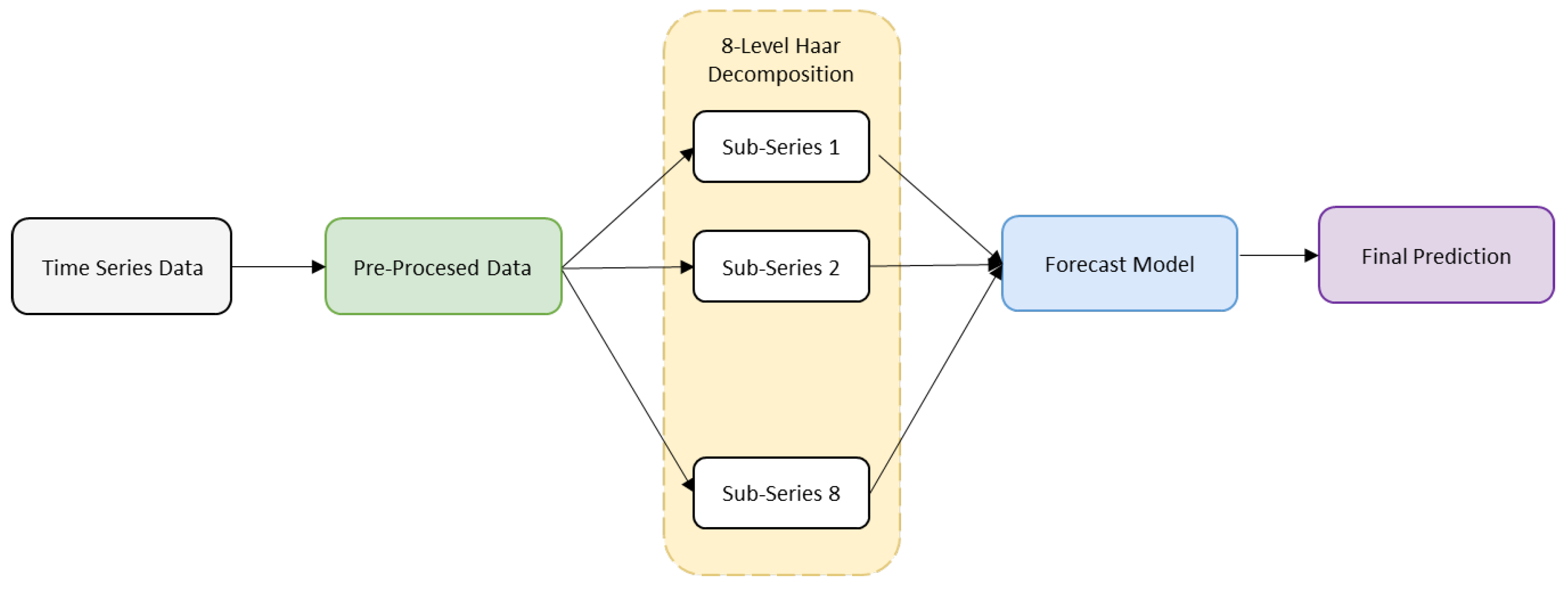

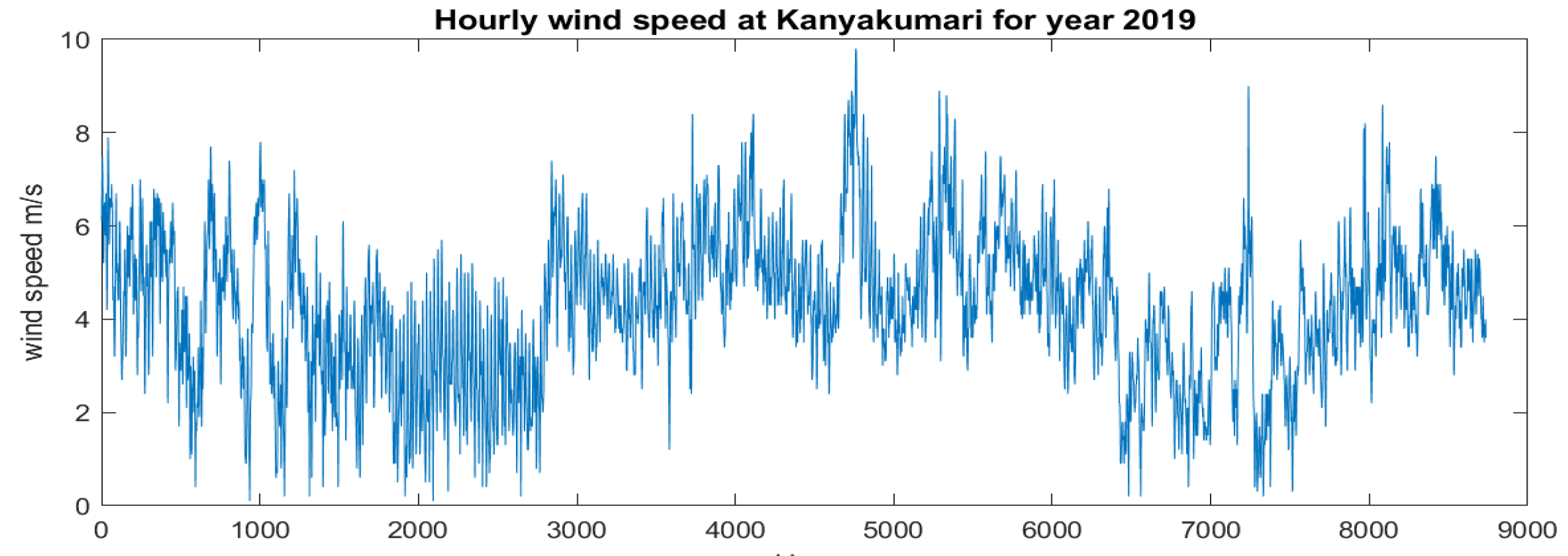
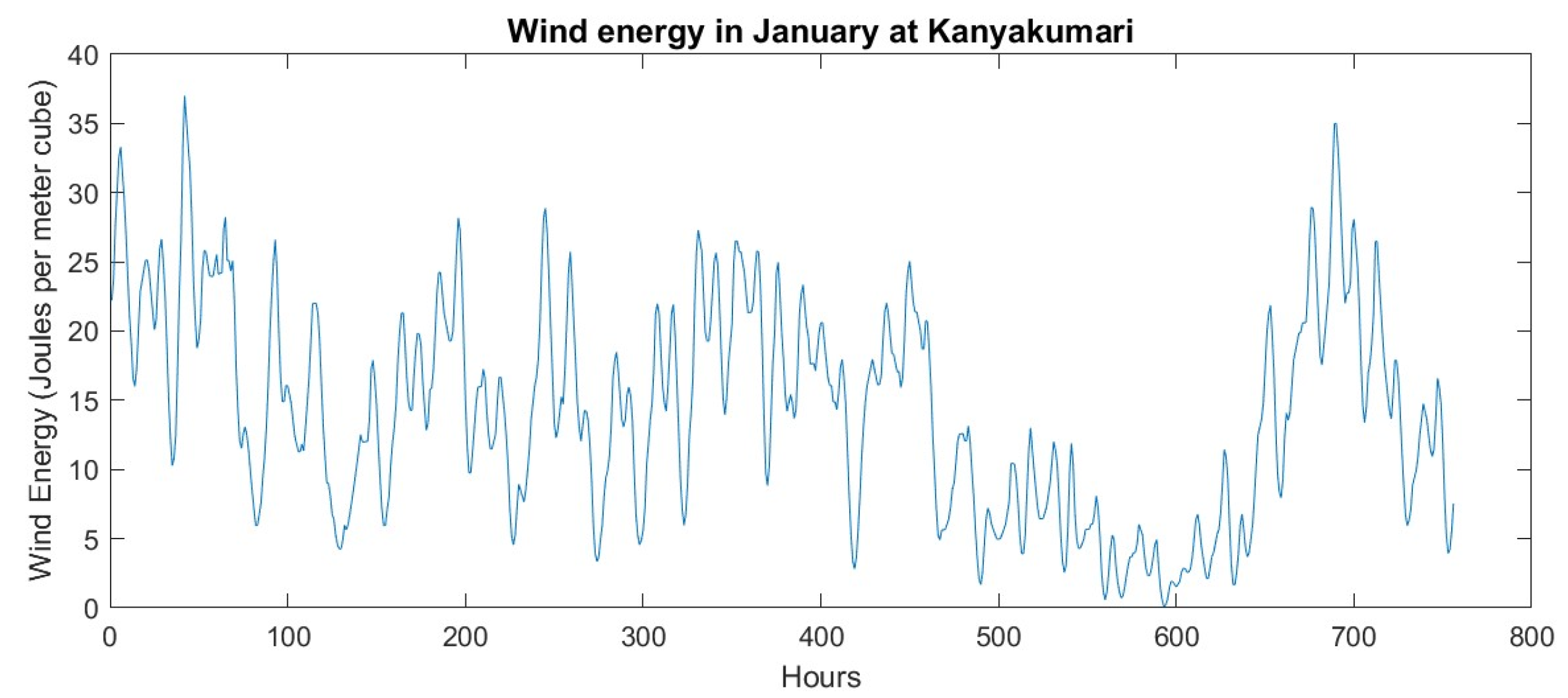

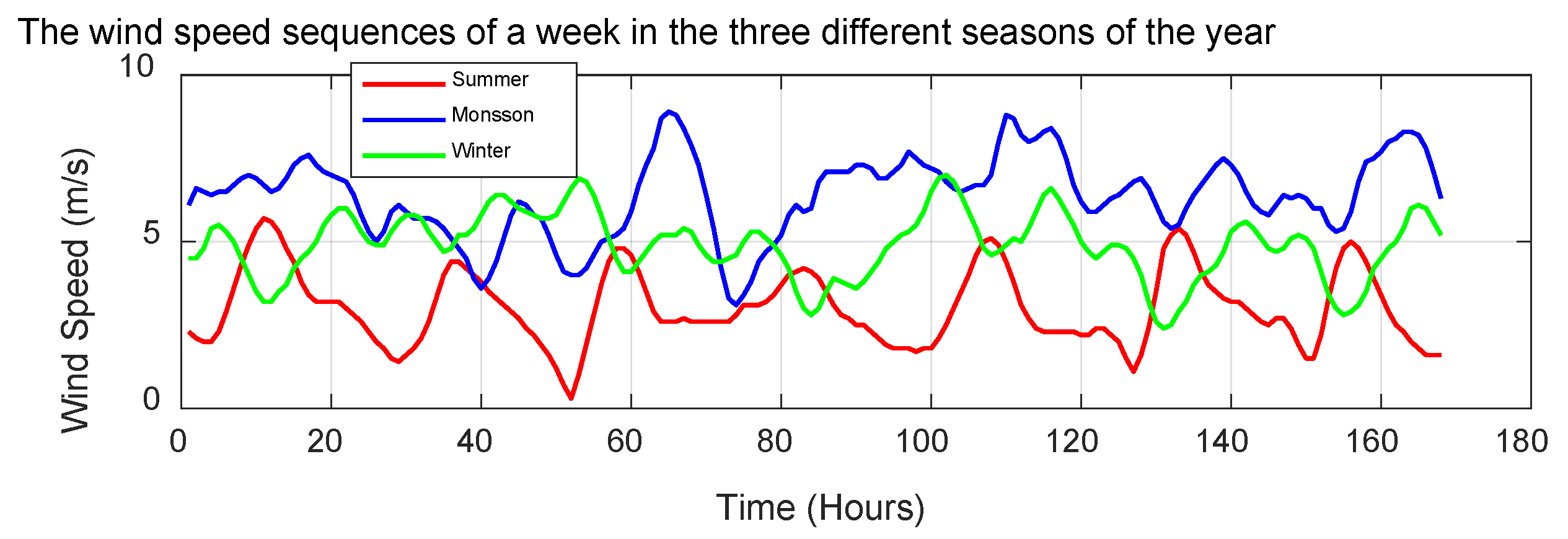
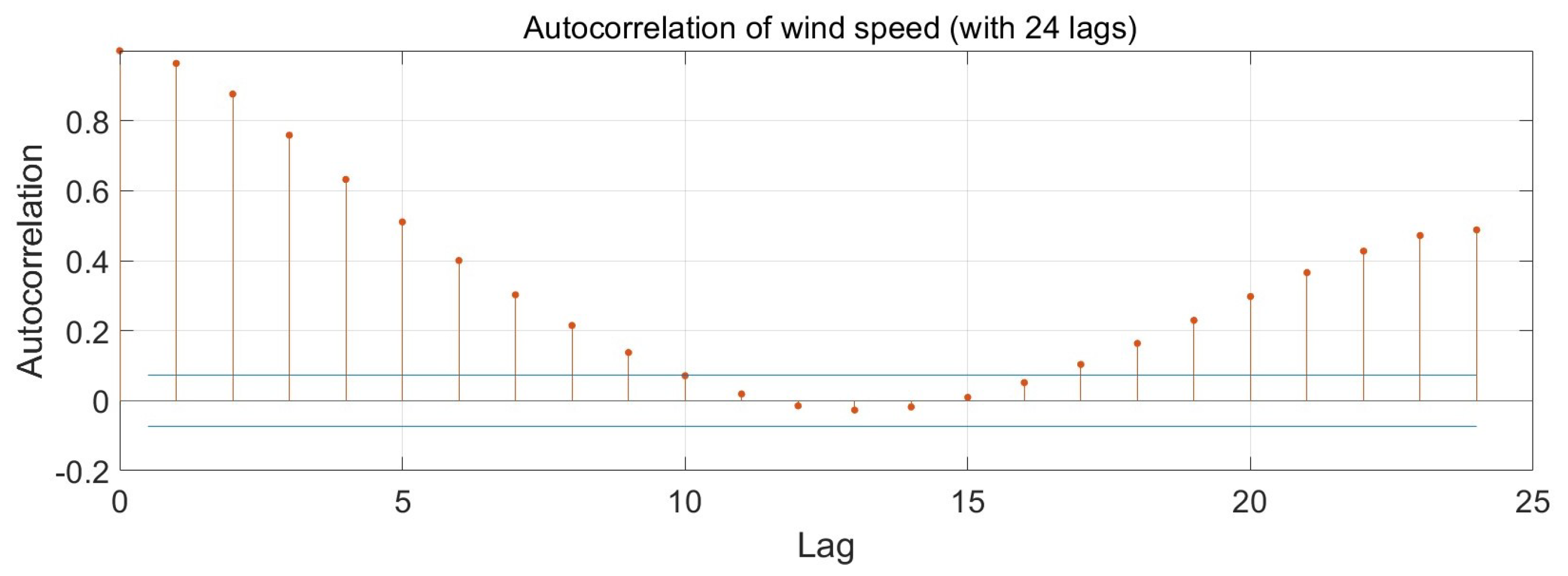
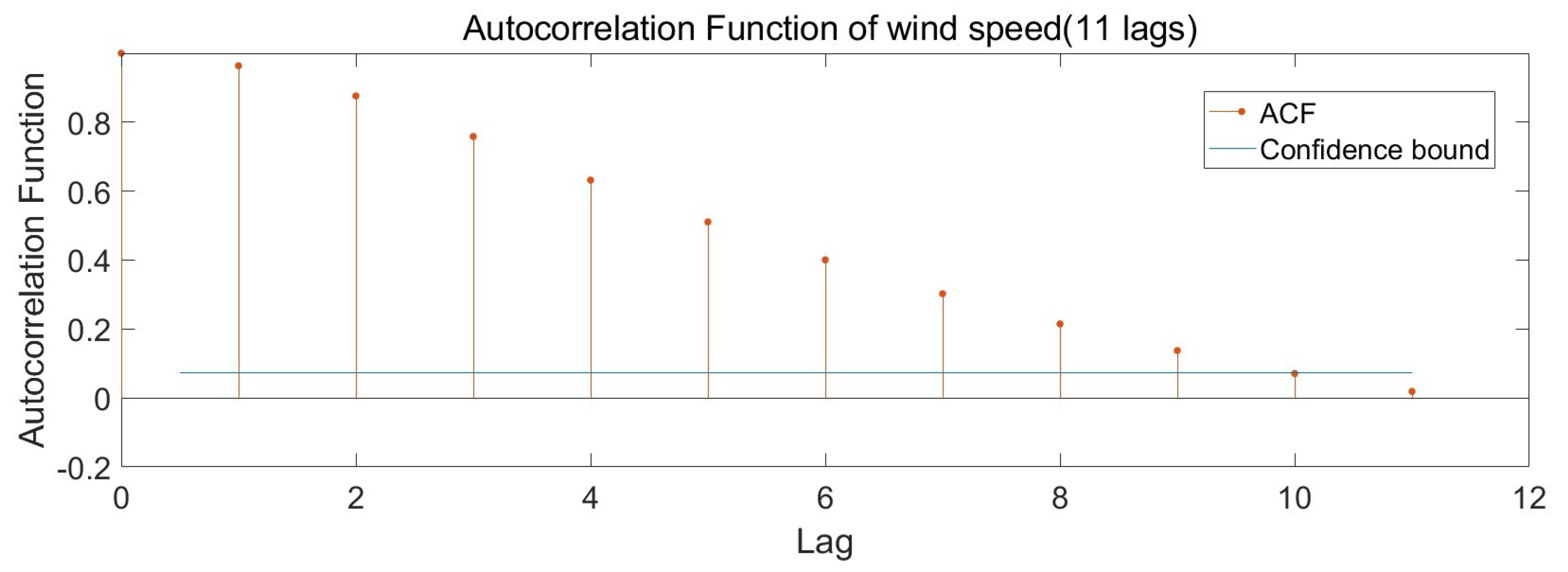
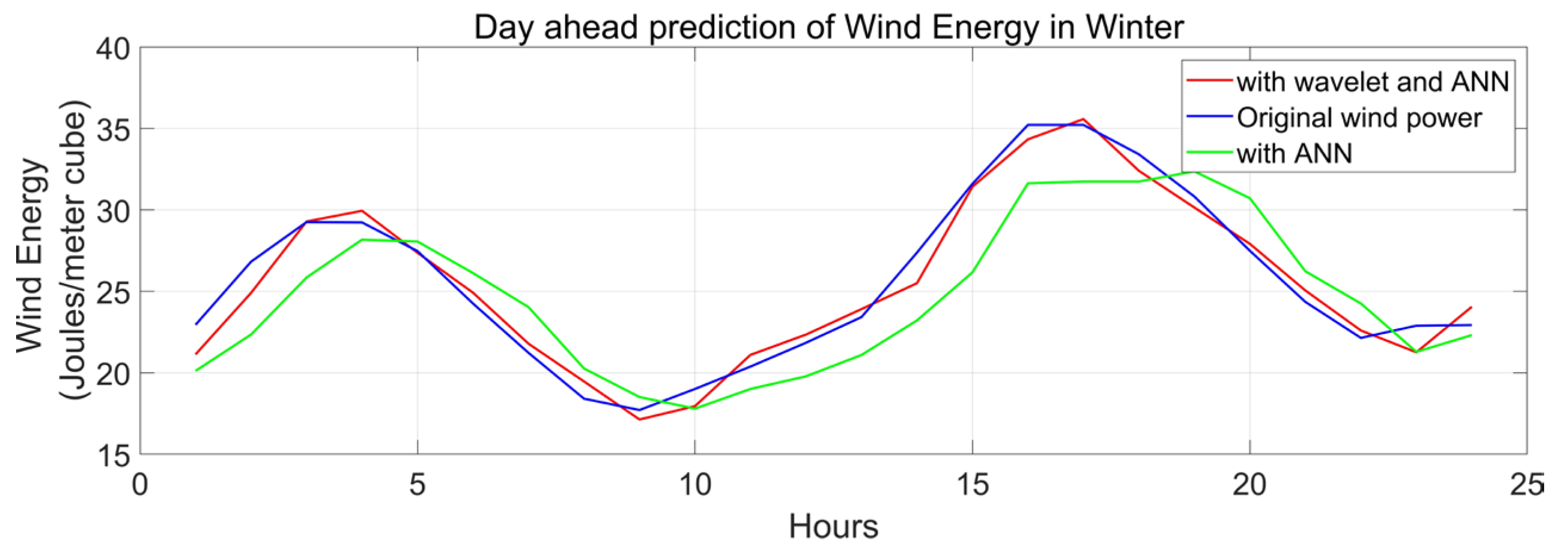
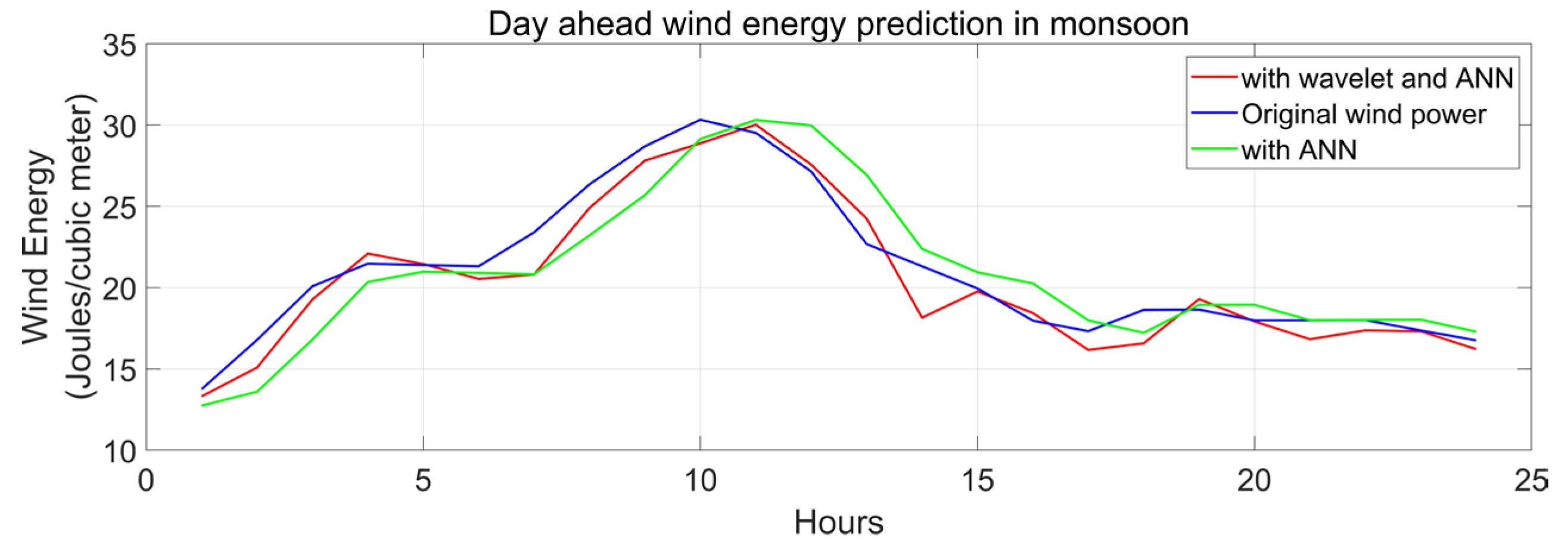
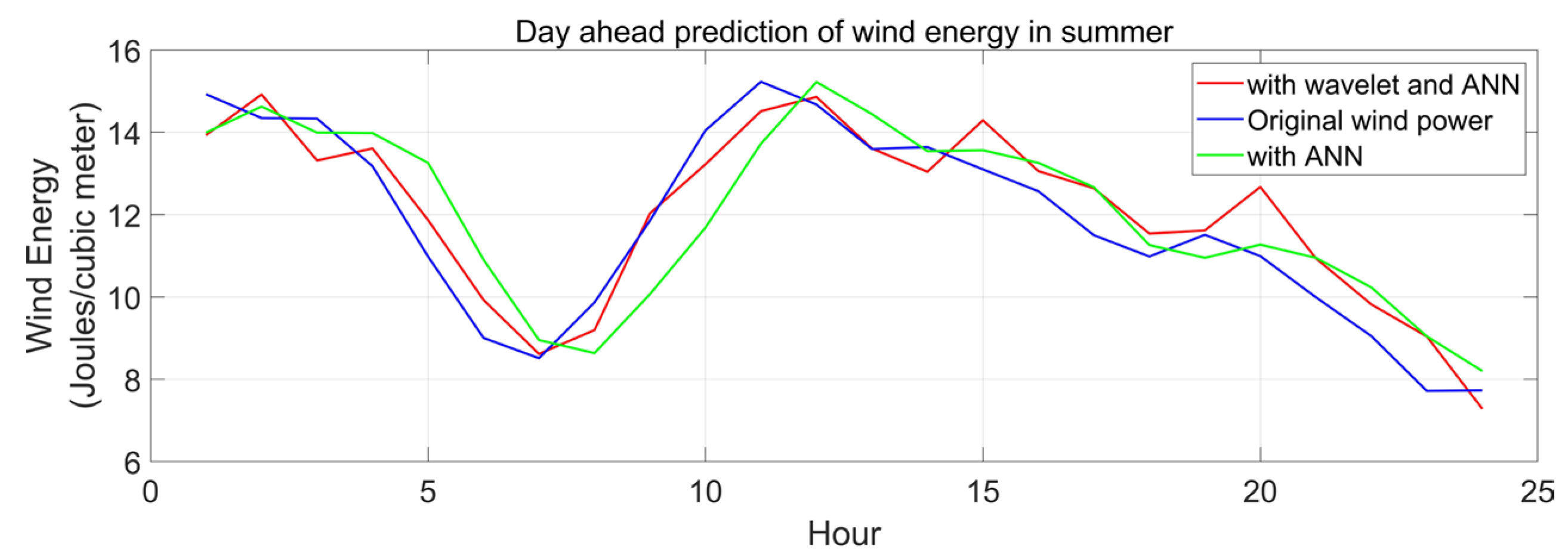
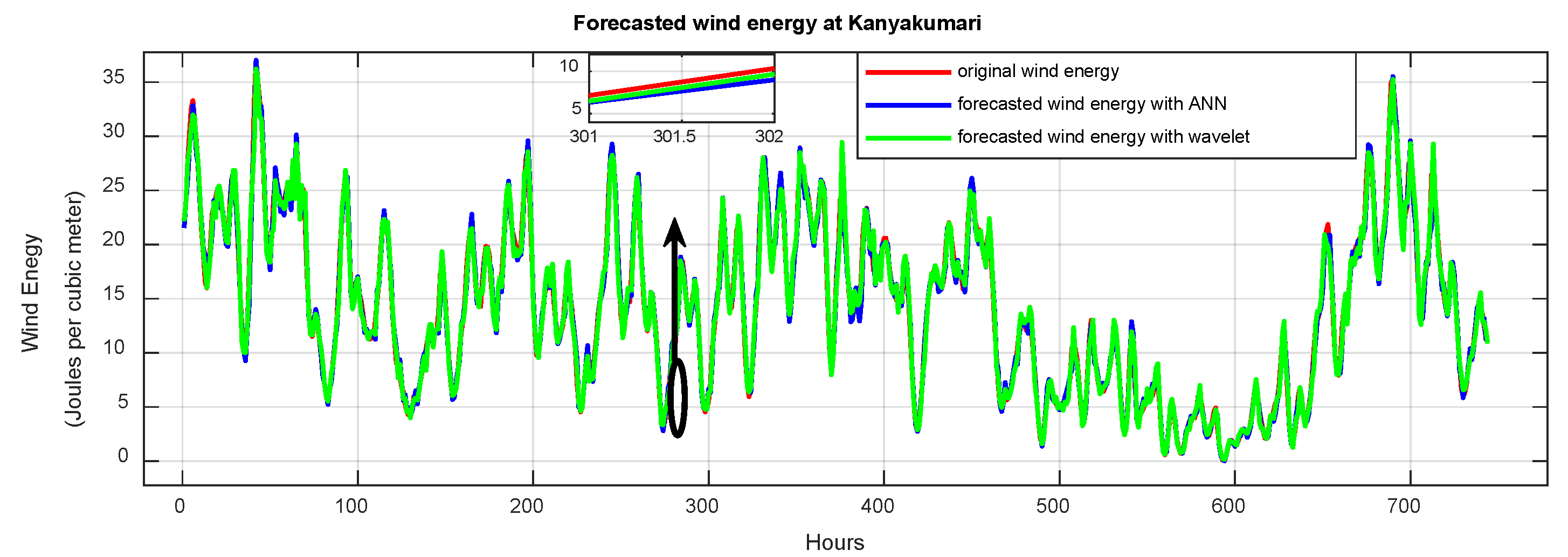
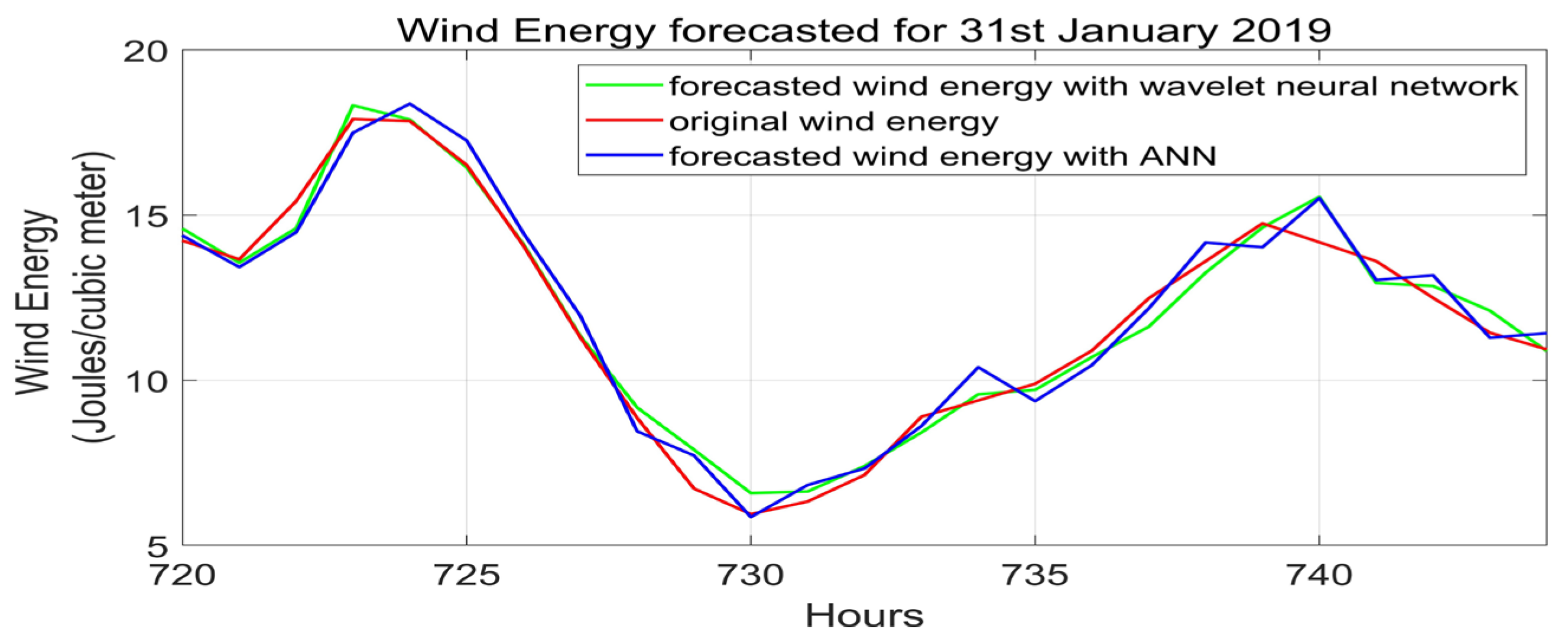
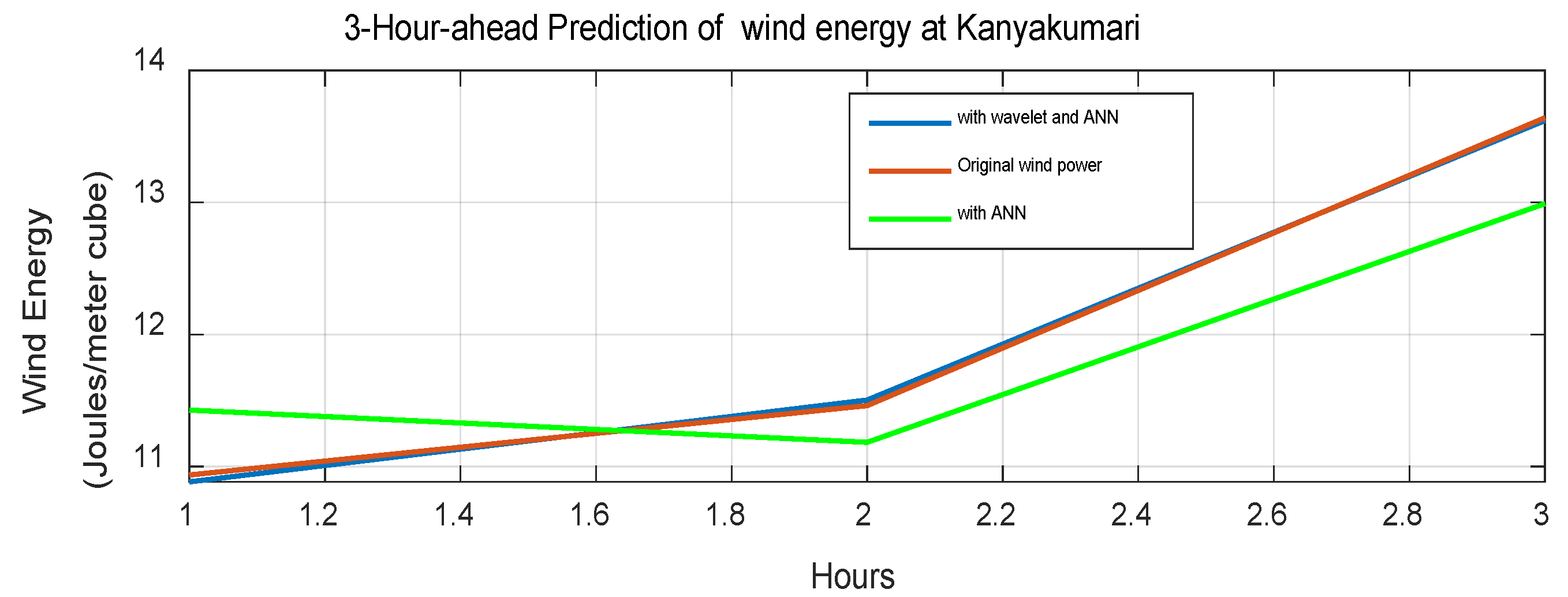
| Method | Description | Strengths | Weaknesses/Shortcomings | Examples |
|---|---|---|---|---|
| 1. Statistical Models | Uses historical wind data to establish patterns and trends. Includes time series models like ARIMA, regression models, etc. |
|
| ARIMA, Linear Regression, Exponential Smoothing |
| 2. Intelligent Learning (AI/ML) | Machine learning models learn complex patterns in data without explicit programming. Includes ANNs, RNNs, LSTMs, SVMs, etc. |
|
| ANN, LSTM, Random Forest, SVM |
| 3. Physical Models | Uses meteorological equations and physics-based simulations (e.g., atmospheric models, terrain, turbine behavior). |
|
| WRF (Weather Research and Forecasting), CFD models |
| 4. Hybrid Models | Combines two or more approaches (e.g., AI + physical, statistical + ML) to leverage their strengths. |
|
| ARIMA + ANN, WRF + LSTM, SVM + Kalman Filter |
| Model | Advantage | Disadvantage |
|---|---|---|
| LSTM | Captures long-term temporal dependencies, works well for multi-step forecasts, effective for seasonal variations | Requires large datasets, computationally expensive, long training times |
| CNN | Good for feature extraction, fast training, effective in hybrid models with LSTM | Lacks temporal memory, struggles with long-range dependencies |
| SVM | Effective with small datasets, interpretable, handles nonlinearity well | Requires manual feature engineering, no native support for temporal dependencies |
| Mean Square Error | Regression Coefficient | |||||
|---|---|---|---|---|---|---|
| Type of Model | Summer | Monsson | Winter | Summer | Monsoon | Winter |
| Direct-Approach WNN | 0.024295 | 0.032753 | 0.016572 | 0.9870 | 0.9912 | 0.9930 |
| ANN Without Wavelet | 0.0482 | 0.072641 | 0.11288 | 0.9782 | 0.9821 | 0.9913 |
| Mean Square Error | Regression Coefficient | |||
|---|---|---|---|---|
| Type of Model | 3 h Prediction | 24 h Prediction | 3 h Prediction | 24 h Prediction |
| Multiple-Component-Approach WNN | 0.000105 | 0.3005 | 0.9981 | 0.9938 |
| ANN without Wavelet | 0.018888 | 0.402191 | 0.9894 | 0.9910 |
Disclaimer/Publisher’s Note: The statements, opinions and data contained in all publications are solely those of the individual author(s) and contributor(s) and not of MDPI and/or the editor(s). MDPI and/or the editor(s) disclaim responsibility for any injury to people or property resulting from any ideas, methods, instructions or products referred to in the content. |
© 2025 by the authors. Licensee MDPI, Basel, Switzerland. This article is an open access article distributed under the terms and conditions of the Creative Commons Attribution (CC BY) license (https://creativecommons.org/licenses/by/4.0/).
Share and Cite
Dias, F.L.; Naik, A.J. A Novel Approach to Wavelet Neural Network-Based Wind Power Forecasting. Wind 2025, 5, 14. https://doi.org/10.3390/wind5020014
Dias FL, Naik AJ. A Novel Approach to Wavelet Neural Network-Based Wind Power Forecasting. Wind. 2025; 5(2):14. https://doi.org/10.3390/wind5020014
Chicago/Turabian StyleDias, Fedora Lia, and Anant J. Naik. 2025. "A Novel Approach to Wavelet Neural Network-Based Wind Power Forecasting" Wind 5, no. 2: 14. https://doi.org/10.3390/wind5020014
APA StyleDias, F. L., & Naik, A. J. (2025). A Novel Approach to Wavelet Neural Network-Based Wind Power Forecasting. Wind, 5(2), 14. https://doi.org/10.3390/wind5020014





